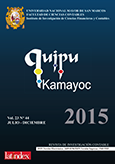CASH MANAGEMENT AND THE CONCEPT OF FLOATING
DOI:
https://doi.org/10.15381/quipu.v23i44.11635Keywords:
Effective management, disbursements in transit, collections in transit, Use of flotation, available, cost effectivenessAbstract
This article aims to investigate some specific situations related to the optimization of cash management and to contribute with officials from the Treasury of com-panies in the effective and efficient management of cash; with the sole aim of achieving or generating an adequate cash flow that allows the company to meet its operational payment obligations and generally achieving money profitability to satisfy shareholders.In this regard, the floating net (or simply floating) -which is the monetary difference between the bank balance of the company and its cash balance books- is generated as a result of the delay in the transfer of checks via mail (postal delay) to be processed by the receiving company (processing delay) and could be compensated through the banking system (delay compensation). This is a particular situation in terms of days in which the Head of treasury of the company could generate large savings (use of flotation), and ac-quire such securities and have considerable profitabili-ty. Whenever you apply drastic measures to accelerate the process of collecting checks, as well as delayed as long as possible in the payment of checks issued.
Downloads
Downloads
Published
Issue
Section
License
Copyright (c) 2015 Félix Hipólito Pajuelo Chauca

This work is licensed under a Creative Commons Attribution-NonCommercial-ShareAlike 4.0 International License.
AUTHORS RETAIN THEIR RIGHTS:
a. Authors retain their trade mark rights and patent, and also on any process or procedure described in the article.
b. Authors retain their right to share, copy, distribute, perform and publicly communicate their article (eg, to place their article in an institutional repository or publish it in a book), with an acknowledgment of its initial publication in Quipukamayoc .
c. Authors retain theirs right to make a subsequent publication of their work, to use the article or any part thereof (eg a compilation of his papers, lecture notes, thesis, or a book), always indicating the source of publication (the originator of the work, journal, volume, number and date).





























